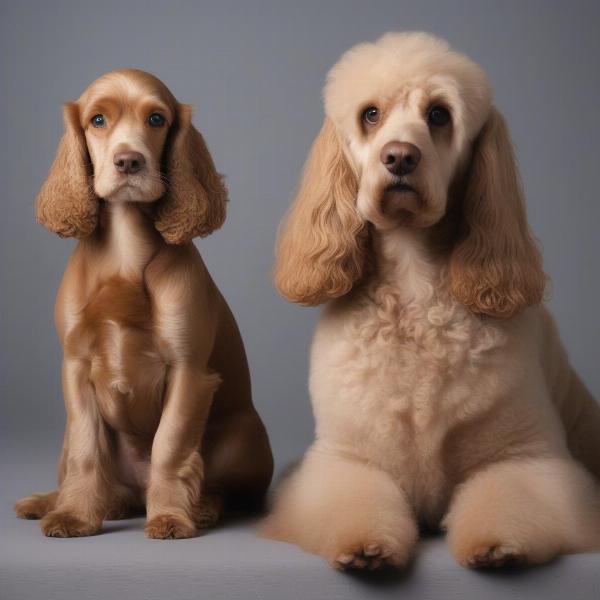Understanding the concept of “Generation P” in dogs is crucial for responsible breeding and ownership. While it’s not a scientifically recognized term like “F1” or “F2” generations in hybrid breeding, “Generation P” within the dog breeding community generally refers to the “Parental” generation. This signifies the purebred dogs used as the foundation stock for creating a mixed breed, often referred to as designer dogs. Knowing what constitutes Generation P is essential for predicting potential health issues, temperament, and physical characteristics in subsequent generations.
Understanding the Significance of Generation P Dogs
The “P” in Generation P stands for “Parental.” These are the purebred dogs from two different breeds that are initially crossed. For instance, if a breeder wants to create a “Cockapoo,” they would breed a Cocker Spaniel (one P generation) with a Poodle (the other P generation). These two purebred dogs form the basis of the Cockapoo lineage. The puppies resulting from this initial cross are then considered the F1 generation (first filial generation). The health and temperament of the Generation P dogs significantly influence the resulting mixed breed offspring. Choosing healthy and well-tempered parents is critical for responsible breeding practices.
 Generation P Dogs – Parental Breeds
Generation P Dogs – Parental Breeds
Health and Temperament Considerations for Generation P Dogs
Choosing the right Generation P dogs is not simply about selecting two purebreds. It requires careful consideration of health and temperament. Responsible breeders perform health screenings on the parental dogs to minimize the risk of passing on genetic diseases. Temperament evaluations are equally important. By carefully selecting Generation P dogs with desirable traits, breeders can increase the likelihood of producing healthy, well-adjusted puppies. This meticulous selection process contributes to the overall well-being of the mixed breed population.
How Generation P Influences Future Generations
The genetic makeup of the Generation P dogs significantly impacts subsequent generations. For example, while F1 generations often exhibit “hybrid vigor,” inheriting the best traits of both parents, subsequent generations (F2, F3, etc.) may have a higher chance of expressing recessive genes and potential health problems. Therefore, understanding the lineage, particularly the Generation P dogs, provides valuable insights into the potential health risks and characteristics of future litters.
Choosing a Breeder Who Prioritizes Generation P Health
When considering a mixed breed puppy, choosing a breeder who prioritizes the health and well-being of their Generation P dogs is paramount. Ask about health screenings, temperament evaluations, and the lineage of the parental dogs. A responsible breeder will be transparent and happy to answer your questions. This ensures that you are getting a puppy from a lineage that has been carefully considered for health and temperament, contributing to a happy and healthy companion for years to come.
Conclusion
“Generation P” in dogs represents the foundation of a mixed breed lineage. These parental purebreds are the starting point, and their health, temperament, and genetic makeup play a crucial role in shaping the characteristics of future generations. Understanding the significance of Generation P contributes to responsible breeding practices and helps prospective owners make informed decisions when choosing a mixed breed puppy. By prioritizing the health and well-being of Generation P dogs, we can ensure the continued health and happiness of our canine companions.
FAQ
- What does “P” stand for in Generation P? “P” stands for “Parental,” referring to the purebred dogs initially crossed to create a mixed breed.
- Why is Generation P important? The health and temperament of Generation P dogs directly influence the traits of subsequent generations.
- How can I find a responsible breeder? Look for breeders who prioritize health screenings, temperament evaluations, and are transparent about their breeding practices.
- Are F1 generations always healthier than later generations? While F1 generations often benefit from hybrid vigor, later generations can also be healthy with responsible breeding practices.
- What should I ask a breeder about their Generation P dogs? Inquire about health testing, lineage, and temperament assessments for both parent dogs.
- Is “Generation P” a universally recognized term? It’s more commonly used within the breeding community rather than in scientific contexts.
- What is the difference between Generation P and F1? Generation P are the purebred parents, while F1 are the offspring of those parents.
ILM Dog is a dedicated resource for dog lovers worldwide, providing expert advice on all aspects of dog care and breeding. We cover a wide range of topics from breed selection and health care to training, nutrition, and grooming. Whether you’re a seasoned dog owner or just starting your journey, ILM Dog has the information you need. We are passionate about promoting responsible dog ownership and the well-being of all dogs. For further assistance, contact us at [email protected] or call +44 20-3965-8624. Visit ILM Dog for more expert tips and resources on dog care.